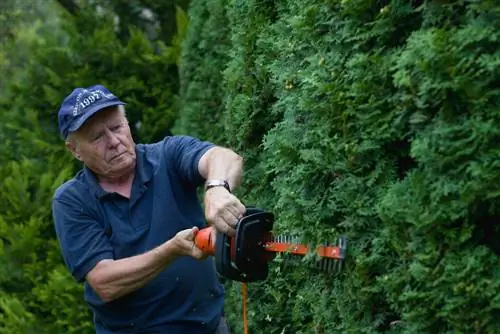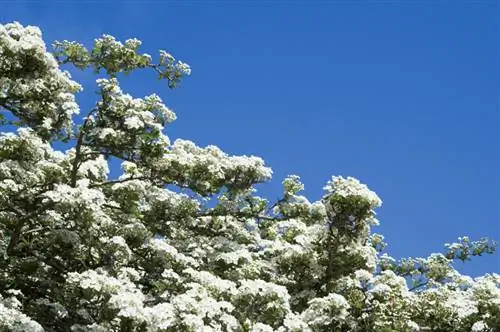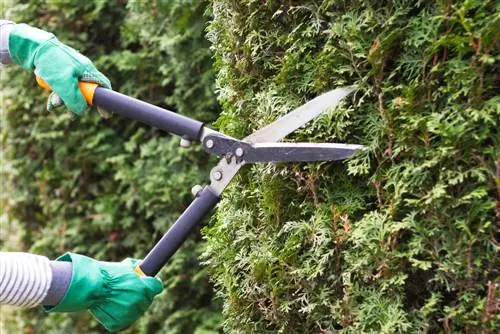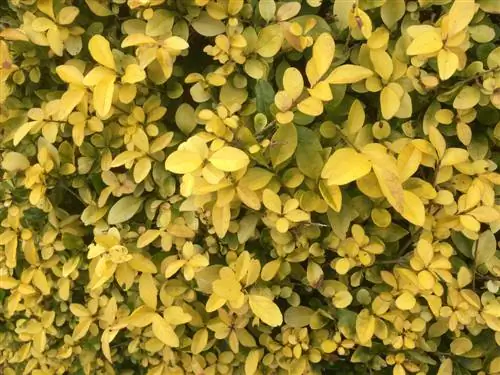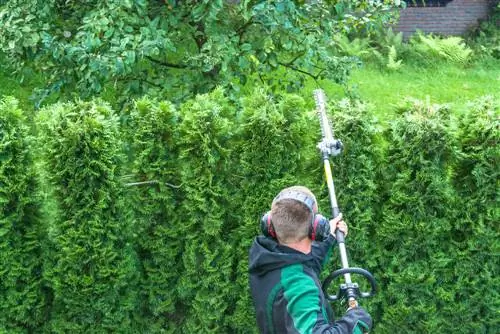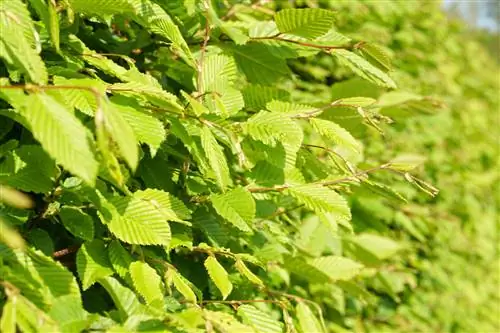- Author admin [email protected].
- Public 2023-12-29 04:51.
- Last modified 2025-06-01 06:02.
Cropping a hedge accurately is not a closed book. This tutorial familiarizes gardening newcomers with all the basics about cutting deciduous and coniferous hedges. Here you can read everything you need to know about the most important types of pruning, the best dates and the skilful pruning for a flawless hedge trimming.
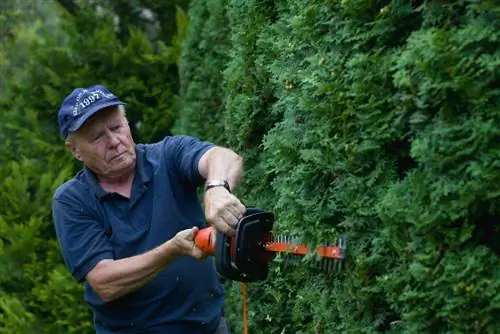
Important types of cuts with dates
In general, a deciduous hedge is easier to cut than a conifer hedge. This principle is based on the fact that most deciduous trees sprout again from perennial and old wood, so that even radical types of pruning, such as rejuvenation pruning, are possible without any problems. Coniferous trees, on the other hand, consistently refuse to sprout if you cut into the unneedled area. Nevertheless, pruning aconifer hedgeis not a difficult undertaking even for the beginner
Thetimingof cutting the hedge is just as important as thecutting techniqueitself. Leave the scissors on a spring-flowering hedge in late winter circle, this year's flowers will fail. Strong-growing hedges should be trimmed at least twice a year. In short: successful cutting of a hedge is based on the knowledge of a fewKey factors The following table summarizes the most important types of cutting with the correct dates:
| Cutting types and dates | Spring-blooming deciduous hedge | Summer-flowering, deciduous or evergreen deciduous hedge | Conifer hedge |
|---|---|---|---|
| Build-up and topiary | after the flowering period | February | February to early March |
| care cut | optional on St. John's Day (June 24th) | End of June to mid-July | End of June to beginning of August |
| Blending cut | End of November to end of February | End of November to end of February | February to early March |
| Rejuvenation cut | End of November to end of February | End of November to end of February | not possible (exception: yew) |
Almost all hedge plants benefit from pruning. Primarily after planting bare-root deciduous trees, you can start strong branching at the base of the bush if you take out the scissors on the same day. Cut all shoots back by half. With this measure you cause a sap to accumulate on the lower buds, which then sprout more intensively. On evergreen deciduous shrubs and conifers, pruning is more moderate by a maximum of 5 to 10 centimeters.
Building a deciduous hedge - dense growth right from the start
Planted in a row, deciduous trees form a dense green wall within a few years. Popular species are hornbeam, field maple and cherry laurel, whose foliage does not allow prying eyes. Flowering shrubs such as serviceberry, cornelian cherry or buddleia, which radiate colorful flowers in addition to the foliage, are also very popular. All hedge shrubs benefit from agradual pruning, which aims at dense branching from the base to the crown. Gradual training during the first few years is the key to success. How to do it right:
- Cut the deciduous hedge twice a year to the desired final height
- With each cut, cut all shoots so that 5 to 10 centimeters of the last growth remain
- Remove stunted branches that grow into the interior of the hedge and are too close together
- Raise sides, flanks and top in equal steps in height and width
As the image below shows, give your hedge a tapered profile right from the start. A hedge should generally be wider at the bottom than at the top. This is the only way to ensure that the branches do not shade each other. Without a continuous supply of light, photosynthesis comes to a standstill and the hedge becomes bare. Cords stretched between wooden pegs serve as orientation.

Treat a deciduous hedge gradually. With each cut, 5 to 10 centimeters of the last growth remain. Prune twice a year, encouraging dense branching from base to crown. When choosing a date, consider whether the shrubs are spring or summer flowering.
Background
Knowing the law of top funding is part of the basics of hedge trimming
If the gardener is familiar with the growth law of peak promotion, he will guide the scissors with a sure hand. The juices flow upwards in every tree. This applies equally to the entire plant and the individual branches. The respectivetip budreceives thestrongest sap pressure and sprouts the most vigorously. On deeper buds, the sap pressure reduces the greater the distance to the tip bud. With a cut, the flow of sap below the cut changes. With the same sap pressure, fewer buds need to be supplied. As a result, deeper buds now sprout more vitally. The gradual pruning takes advantage of this connection by cutting off the respective top buds so that the hedge branches richly from the base.
Skillfully cut the leaf hedge into shape - instructions for beginners
Once the deciduous hedge has reached the desired height and width, the pruning care results in an annual shape and maintenance cut. For the majority of popular hedge plants, a single cut is sufficient to ensure a well-groomed appearance. With the exception of early-flowering hedge bushes, February has proven to be the ideal period. There is no risk of disturbing nesting birds. As a result of a longer regeneration period after early pruning, the trimmed hedge appears as if it had been peeled back by May. How to complete a professional shape and maintenance cut:
- Clean and disinfect cutting tools in advance
- Tighten the cords as a guide for the advantageous trapezoid shape
- In the first step, thin out all dead wood as well as unfavorable and weak shoots
- Then trim all sides of the hedge to the desired extent
- Always work facing the uncut area
The order in which you devote yourself to the hedge pages is your personal decision. Many home gardeners cut the hedge crown in advance. This has the advantage that the proportions for the sides and flanks can be better estimated. A cherry laurel hedge with a large volume is more effective than tree-like hornbeam hedges.
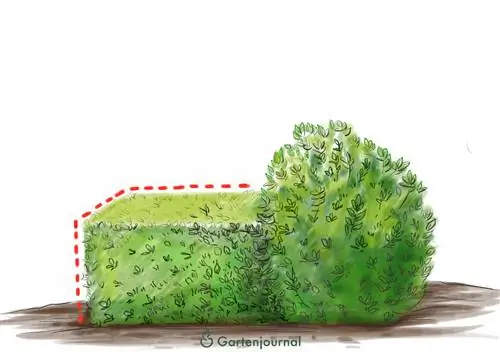
Cut a formal deciduous hedge into the desired shape in February. In June/July the maintenance pruning is dedicated to this year's growth. The trapezoidal shape with a wider base guarantees light-flooded, densely leafy growth.
Excursus
Cutting large-leaved deciduous hedges better with manual hedge trimmers
Hedges made from large-leaved deciduous trees are very popular with private gardeners. A prime example is cherry laurel, which impresses with shiny green leaves up to 14 centimeters long. You can complete the perfect hedge trimming with manual two-handed scissors. Thanks to controlled cutting, you can achieve a flawless cutting appearance. In contrast, the decorative leaves are mercilessly shredded by the counter-rotating blade bar of an electric hedge trimmer.
Cut the strong-growing deciduous hedge again in June - instructions for care cutting
John's Day (24. June) has had its day as the traditional date for trimming hedges. Long-term field tests by the Saxon State Horticultural Institute have shown that almost all hedges grow denser and more evenly if themain cut is carried out in February. The date was not completely deleted from the pruning care, because strong-growing deciduous hedges benefit from a lightcare pruning at this time.
Light care pruning specifically means that you cut back thethis year's growthby about a thirdThe pruning shouldn't be more extensive, as the hedge plants Otherwise you will lose too much of its substance. The remaining leaves are important for building up nutrient reserves for the autumn and winter. The time window for hedge trimming only opens again in February.
Stay true to the advantageous,conical hedge shape when it comes to pruning. As the image below demonstrates, sloping sides and flanks on your hedge guarantee light-flooded growth. Cords stretched between sticks are helpful for orientation during cutting work.

Always cut a deciduous hedge in a moderate trapezoid shape. With a wide base and narrow top, the branches cannot shade each other and the hedge remains densely branched and richly leafy everywhere.
Tip
A hedge made of spring-flowering shrubs, such as forsythia or gorse, should no longer be cut after St. John's Day (June 24th). At this time the flower beauties are busy putting on buds for next year. No hedge trimmers should get in the way of the trees, which would destroy all hopes of a spring-fresh blossom festival.
Rejuvenate deciduous hedges successfully - step-by-step instructions
You can revitalize an old, bare and misshapen deciduous hedge by cutting the bushes well into the perennial wood. Many home gardeners shy away from radically growing a hedge. A rejuvenation cut that is divided into two to three stages is gentler and more successful. The following instructions explain step by step how to do it correctly:
- First step: in late winter, cut back the top and one side to short cones with a branch
- Second step: shorten the other flank in late winter to a stub with a side branch
- Parallel to the second step, shorten the fresh shoots on the top and flank by a third
It depends on the type of tree how quickly new shoots appear from the sleeping eyes of the stub. For some hedge bushes the process can take one to three years. While you wait, continue your nutrient and water supply unabated.
Background
Hedge rejuvenation is subject to legal regulations
Raising awareness of the need to protect nature is expressed in the Federal Nature Conservation Act. Paragraph 39 is dedicated in detail to the pruning of all types of trees and lays down strict regulations for the choice of dates. Radical pruning measures, such as putting a hedge on the tree, are limited to the period from October 1st to February 28th. The grace period, which only allows light maintenance cuts, extends from March 1st to September 30th. Before cutting any hedge, it is important to ensure that no wild animals are disturbed, driven away or affected in any way.
Building a conifer hedge requires patience - here's how it works
It is the brilliant coniferous hedges that give the famous castle gardens and legendary parks a magical ambience. Home gardeners rely on thuja, yew and other conifers when it comes to creating a windproof and opaque hedge as a fence or border. The most important difference to deciduous shrubs is that coniferous trees no longer sprout from old, unneedled wood. A gradual structure is therefore particularly important for coniferous hedges. This is how the hedge thrives, dense and compact right from the start:
- Cut twice a year, in February and June
- Leave 3 to 5 centimeters of new growth with each cut
- Train the conifer hedge in a trapezoid shape from the start
- Cut off shoots directed towards the interior of the hedge and noticeably weak branches at the base
Be critical when purchasing conifers. On average, 5 to 10 years are invested in the professional cultivation of a coniferous hedge. To make the time investment worthwhile, only choose young bushes that are already upright and densely bushy. Wide or columnar plants are not suitable for hedge planting. The fast-growing border yew 'Hillii' (Taxus media) and the popular arborvitae 'Smaragd' (Thuja occidentalis) are recommended.
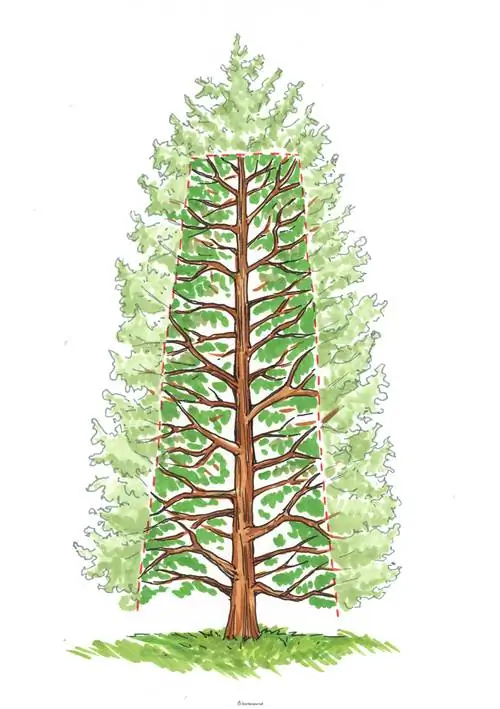
Building a densely needled conifer hedge requires a step-by-step approach. Prune cautiously in February and June in the green area. The conifer hedge should have gained a maximum of 5 centimeters in height after each cut.
This is how the conifer hedge stays in perfect shape
Once your conifer hedge has reached the desired height, pruning care continues with an annual topiary cut. Depending on the type of softwood, pruning is on the gardening schedule in February and June/July. Continue to only move with the hedge trimmer in the green area so that no brown spots or holes appear. Nevertheless, you should get as close as possible to the previous interfaces. If you only add 1 centimeter per side for each topiary, the hedge will gain another 20 centimeters in width within 10 years. On small properties, this creates a space problem over time.
Excursus
Cut correctly for an accurate cut pattern
Use simple tricks to effectively prevent wavy hedge flanks and a crooked hedge crown. Before you start cutting, stretch a string between two rods as a guide line for orientation. When cutting, stand next to the hedge so that you can see both the cord and the uncut area of the hedge. Hold the scissors parallel to the hedge with your arms stretched out and cut from your shoulders using even pivoting movements. Dents in the hedge crown can be avoided if you hold the blade bar of the electric hedge trimmer horizontally and swing it out of the back.
Rejuvenate the yew hedge - this is how the ambitious project succeeds
Coniferous trees are not suitable for radical rejuvenation pruning - with one exception. The vigorous yew has a good-natured pruning tolerance and can handle even a strong cut into old wood. While thuja, cypress, fir and pine consistently refuse to sprout again from unneedled shoots, a yew even sprouts fresh branches directly from the trunk. As the figure below illustrates, a step-by-step approach makes sense. This is how it works:
- The best time is in late winter until March 1st, in accordance with growth and the Federal Nature Conservation Act
- First stage: cutting back one side of the hedge except for short stubs on the scaffolding shoots
- Second stage: Trim the top to 50 centimeters below the desired final hedge height
- Third stage: Cut the second side of the hedge except for short cones on the shrub frame
If you follow this cutting strategy, your hedge will always have sufficient needle volume to create reserves for new growth. Following the third stage, initiate the growth into a dense conifer hedge with a gradual pruning.
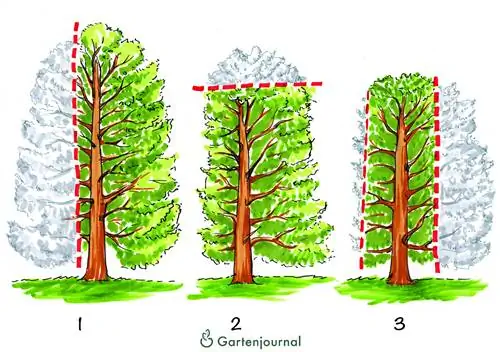
The yew hedge is the only conifer that tolerates rejuvenation. Proceed in stages. In the first year you cut off one side and one flank, in the second year you shorten the height of the hedge plants. Last year cut the other side and flank.
Frequently asked questions
Are there hedge bushes that grow quickly, provide year-round privacy and are easy to cut?
Firethorn 'Red Column' (Pyracantha coccinea) is one of the premium varieties of fast-growing and evergreen hedge shrubs. With an annual growth of up to 60 centimeters, the privacy protection function doesn't take long to arrive. Equipped with long, sharp thorns, a firethorn hedge reliably repels uninvited guests. As a rule, a shape and thinning cut after the flowering period in June is sufficient to ensure that the hedge remains dense and vital. Protecting the gardener from the thorns is the only challenge in pruning care. The large-leaved barberry (Berberis julianae) and the resulting, pruning-tolerant varieties score points with similar advantages.
I would like to plant a deciduous hedge on my fenced property, preferably with hornbeam bushes as a privacy screen. How big should the planting distance be between the fence and the hedge? How often does a hornbeam hedge need to be trimmed?
A distance of 50 to 60 centimeters from the fence is advisable. This means the hedge can grow sufficiently wide and you have enough space for pruning. Hornbeams receive extensive shaping and thinning in February. For a well-groomed appearance, cut back this year's growth between the end of June and mid-July.
We live in a snowy region. Every year my thuja hedge almost collapses under the white load if I don't regularly sweep the snow away from the hedge crown. How can I prevent this evil?
As beautiful as a hedge with a white cap is to look at, there is still a considerable weight on the crown. To effectively prevent snow breakage, we recommend a special hedge shape with a tapered crown and a wide base. The smaller the hedge area at the top, the less snow can accumulate.
I'm annoyed by several gaps in my boxwood hedge. What can I do about it?
The causes are varied, the result is always annoying. Gaps and holes spoil the well-kept appearance of a boxwood hedge for many years. If shadows from neighboring plants are the cause, please cut them back accordingly. You can close the gaps more quickly with a simple gardening trick. Bridge the distances between adjacent shoots with bamboo sticks placed horizontally or diagonally. If you cut the tips of the shoots a little, you also stimulate growth and within a short time you will no longer be able to see the gap.
A formal deciduous hedge is to my taste. I would much rather plant a free-growing, mixed flower hedge. What should you pay attention to when cutting?
Free-growing flower hedges are an enrichment for every garden. As a flower-rich refuge for birds and small animals, the hedge can also serve as an enclosure and privacy screen. Pruning care is more reserved than with formal deciduous hedges. Annual thinning in late winter is more important than pruning branches. Continuous rejuvenation is beneficial for opaque growth. In January or February, you thin out the oldest ground shoots in exchange for young shoots. The time for cutting depends on the flowering period. Prune spring-flowering shrubs at the end of the flowering period. Summer-flowering hedge bushes are pruned in late winter.
I planted my privet hedge in mid-May. Without pruning it has now reached a height of a good 70 centimeters in October. The goal is a 1.50 meter high, opaque hedge. Unfortunately, I have only just read your instructions for cutting. When and how do you recommend pruning under these conditions?
There is nothing wrong with cutting back the hedge by a third now (mid-October). Alternatively, leave the plants as they are and cut them at the best time in February. Prune the hedge plants a second time at the end of June. Shorten the new growth by a third. Since privet is a fast-growing deciduous tree, you can do another moderate cut during the development phase in September/October to support bushy branching. Please ensure there is an adequate supply of water and nutrients.
The 3 most common cutting mistakes
If the hedge is bare from the base, is marred by brown spots and holes, or no longer sprouts after a rejuvenation cut, gardeners have fallen victim to a pruning error. To protect readers of this tutorial from the worst hedge trimming mistakes, the following table lists common mistakes with tips for prevention.
| Cutting errors | malicious image | Prevention |
|---|---|---|
| not cut into trapezoid shape | premature baldness from below and within | Always cut the hedge with a wide base and a narrow crown |
| radically put on the stick | Total loss of all hedge bushes | Rejuvenate deciduous hedges in stages |
| Conifer hedge heavily cut back | brown spots and holes in the cross-sectional image | Always cut conifers in the needled area |
A common failure to trim hedges does not result from a cutting error. If unclean scissors are used for pruning, diseases and pest infestation are inevitable. Statistics have proven that the spread of fungal infections, aphids and other nuisances is primarily due to uncleaned blades, saw blades and knife bars. Before each hedge trimming, please clean the tool with hot water and then disinfect it with alcohol.

Tip
Transplanting requires unscheduled hedge trimming. It often becomes apparent within the first five years of existence that a hedge is too close to buildings, streets or neighboring properties. The successful change of location depends largely on the fact that you cut the hedge bushes by a third or half beforehand or afterwards.

